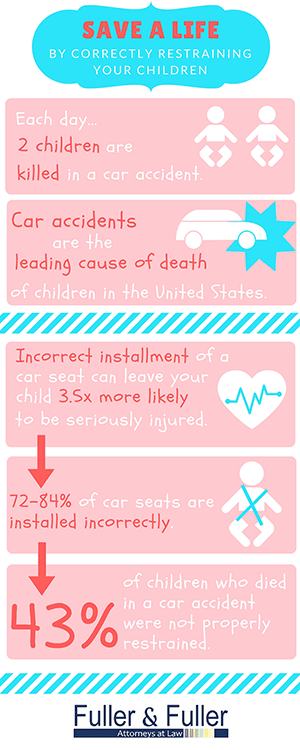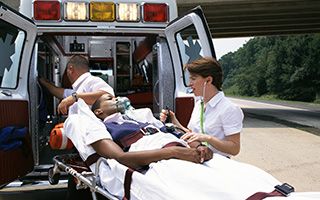
According to the Insurance Institute for Highway Safety (IIHS), nearly two children are killed each day in car accidents. In fact, , “passenger vehicle occupants accounted for the majority of motor vehicle crash deaths for all age groups of children.” Many of these deaths could have been prevented if a car seat was used correctly.
Incorrect installment of a car seat increases a child’s risk of serious injury by up to 3.5 times. Anywhere from 74% to 84% of child restraints used across the country are critically misused. According to saferide4kids.com, 33% of children who died in a crash were not restrained in any way, and 43% of children who died were not “properly restrained.”
How to Properly Install a Car Seat
Through no fault of their own, many parents are not aware that their child’s car seat is installed incorrectly, or that the car seat they are using is not the correct size for their child. There are many steps a parent can to take to make sure that they’re installing a car seat correctly. According to the CDC, parents should:
- Use the correct car seat, booster seat or seat belt for your children. Which option is appropriate will depend on the child’s age, height, and weight.
- Use the proper restraint system every time the child is in the vehicle, regardless of how short the trip is.
- Always have children sit in the back seat. The middle of the back seat is also the safest place in the car.
- Never seat children in front of an airbag.
- Use a rear-facing car seat for infants under the age of two.
- Use a forward facing car seat for children ages two to five.
- For children five and up, use a booster seat until a seat belt fits them properly. Seat belts should fit so that the lap belt lays across the upper thighs, and the shoulder belt lays across the chest.
- When the seatbelt fits properly without the child sitting in a booster seat, have the child use a seat belt.
- Make sure you install and use the car and booster seats correctly. If you need help, there are certified Child Passenger
- Safety Technicians who can assist you. The National Child Passenger Safety Certification Program has a checklist for what to do to prepare for meeting with a CPS Technician, and what to do during the car seat checkup.
- Be a role model for children and always wear a seat belt.
Common Injuries From Car Seat Misuse
Car accidents can cause severe damage no matter what age, height, or weight a person is. When small children and babies are involved in a car accident, catastrophic injuries can occur. Common injuries sustained by children in car accidents can include but are not limited to:
- Spinal cord Injuries
- Traumatic Brain Injuries (TBI)
- Broken, Fractured, or Shattered Bones
- Internal Bleeding and Organ Damage
- Mild to Severe Strap Burn
- Choking
- Mild to Severe Bruising
- Mild to Severe Whiplash
- Death
To minimize the chances of any of the above injuries happening to a child, it is important to take all necessary measures to make sure their car seat is properly installed and is the correct size for their body type.
What Is Washington’s Car Seat Law?
Just like the rest of the United States, Washington has car seat laws to ensure the safety of children across the state.
Under the Age of 1
According to Washington Law, infants are required to ride in rear-facing car seats until they are at least one year old or over 20 pounds. The American Academy of Pediatrics (AAP) recommends that parents keep children in rear-facing car seats up until children are at least two years old. Weight limits for car seats are also very critical. Be sure to check the weight limits for your child’s car seat and adjust them to a new seat if they are below or above the required weight limits for that particular seat.
Ages 1 to 4
It is recommended that children who are one to four years old ride in a forward-facing car seat. Weight-limit is important as well. If the child is over 40 pounds, a forward facing car seat, with a five-point harness is highly recommended. The AAP recommends that children who are below 4 foot 9 ride in a “belt-positioning booster seat.”
Ages 4 to 8
This is the time that children who meet height, weight, and age requirements can move to a booster seat. Any child who is under 4 foot 9 cannot properly use a seatbelt.
Ages 8 and Above
Children who are eight years old and above and meet all requirements, are to sit in the back seat. According to Washington’s Seat Belt Law, no one may operate a motor vehicle unless all persons under the age of 16 are wearing a seatbelt. To ensure optimal safety, all children 13 years old and younger must ride in the back seat, as it is the safest place in a car according to the CDC.
September is Baby Safety Month
Every September is “Baby Safety Month.” At Fuller & Fuller Attorneys at Law, we are invested in helping our clients, and the people of Washington protect their loved ones. Family is of the utmost importance to us, and we want to make sure your family is as safe as possible. If you have a young child, we encourage you to take all of the necessary steps to correctly fitting and installing their car seats. Together, we can take measures to reducing the number of children’s lives that are taken due to car accidents. We take pride in treating you like family. If you or someone you know has been involved in a car accident, contact us, and we will help you pursue legal action.
To embed this infographic on your website, simply copy and paste the HTML below.







